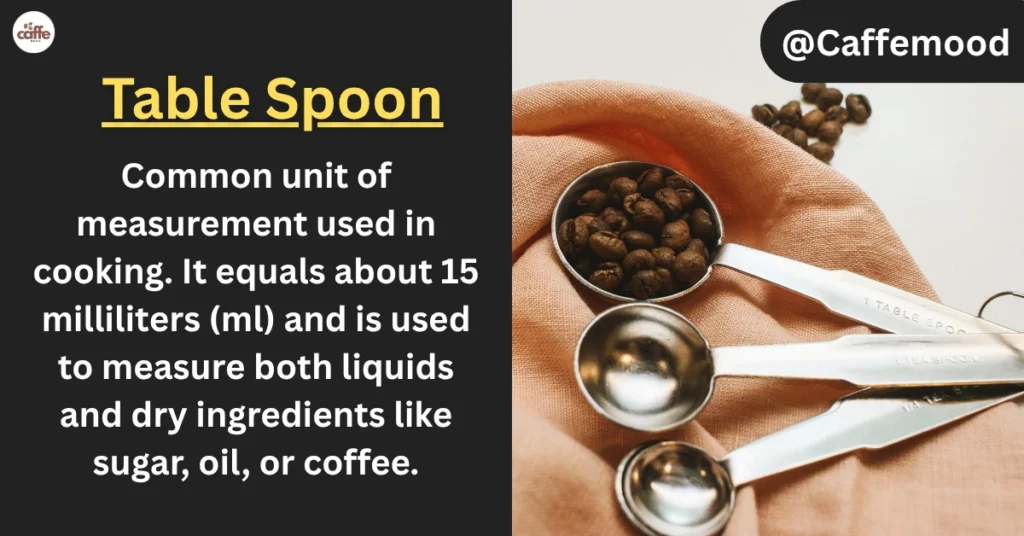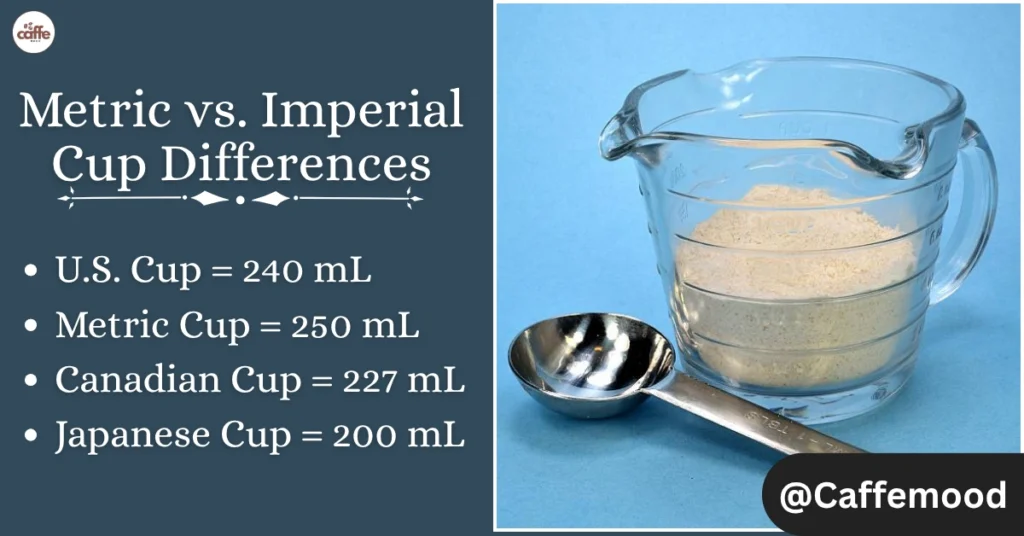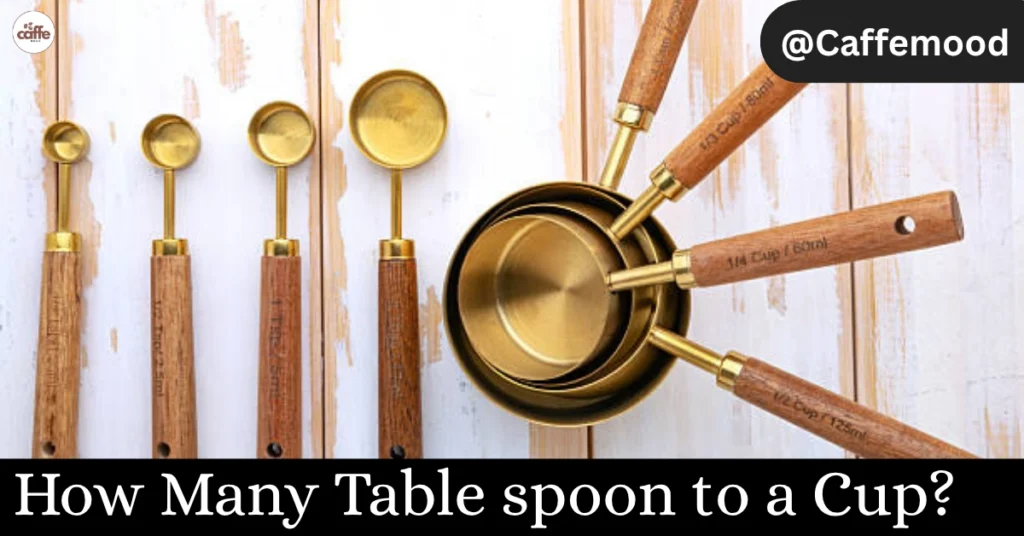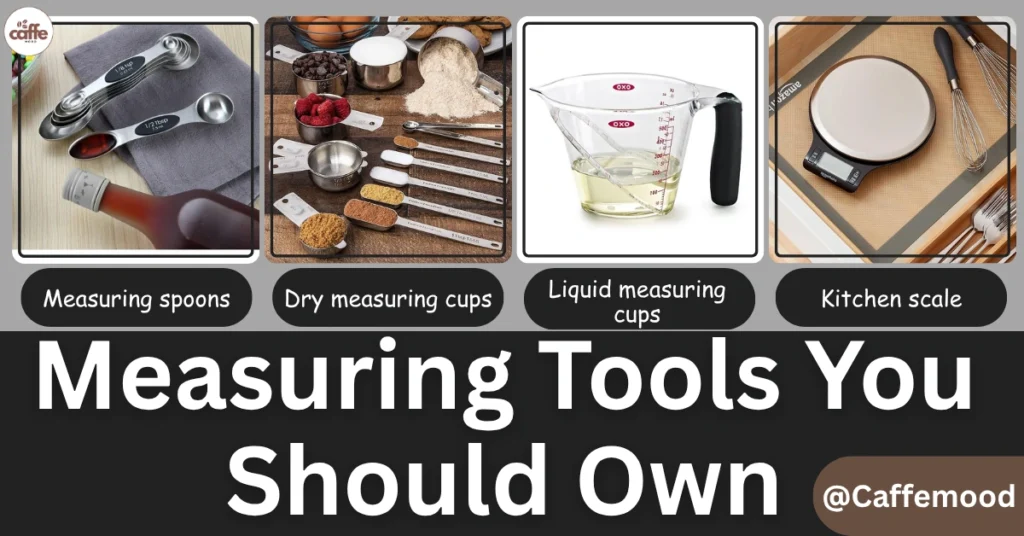How Many Table spoon to a Cup? Easy Conversions & Charts

Cooking is the beautiful art of science. Precision is important and also the taste and the presentation, especially when it comes to measuring the exact amount. One of the most searched and people looking for the precision in home kitchen related equipment is ‘’table spoon to a cup’’, and let’s see why? Whether you are trying to make a unique recipe like you have never tried before, understanding your tablespoon will directly relate your recipe as it will become delicious or a disaster.
Let’s break it down with this complete guide in easy reading score: How many Tablespoons to a cup?
Table of Contents
Introduction to Kitchen Measurement Conversions
Why Precise Measurements Lot More Important in Cooking
We all have tried a recipe and ended up with something unexpected in our life because of the incorrect measurement of our recipes. Exact conversions between units like tablespoon to cup are the measure source of maintaining the texture, flavor and appearance of your dish. Little changes in oil, sugar or flour can change your dish into something wasted. Understanding the kitchen measurements can help your dishes be made with perception and more valuable every time.
Question for you, have you ever tried to make something and ended up with expectation vs reality situation?
Overview of Common Kitchen Units
In the dietary world, we normally measure in teaspoons, tablespoons, cups, milliliters, and grams. The real question arises when switching between these, especially between volume in cups or tablespoons and weight in grams. The tablespoon and the cup are the most commonly used units, especially in Western cooking styles. It will save you a lot more precious time if you learn how to convert it within seconds and become an expert on cooking.
What is a Tablespoon?

Standard Sizes in Different Countries
Tablespoons are differently found in different countries. Like, in the United states, one tablespoon is equal to 14.79 ML and in Australia it’s 20 ML. This difference is very normal, but it will drastically impact on your recipe especially if you are cooking with your full precision.
U.S. vs U.K. Tablespoon Differences
- U.S. tablespoon = 14.79 mL
- U.K. tablespoon = 15 mL (modern standard)
- Australian tablespoon = 20 mL
It’s very important to know when you are converting your ‘’tablespoon to cup’’ for which country you are using it for. Checking the origin of the recipe is the best choice. Still if something comes out your milk then use a kitchen scale or measuring spoon labeled with metric or imperial units.
Check Full Guide For U.S. vs U.K. Measurement in Details here; – US and UK measurements compared
Understanding the Cup as a Measurement
How Cups Are Used in Recipes
Cups are usually used in the U.S, Canada or Australia because cup measurement originated from these countries to measure the volume for the recipes. It’s a simple and easy way to measure sugar, rice or flour in large quantities. However, tablespoons and cups are slightly different in regions which can make your conversions tricky and difficult.
Metric vs. Imperial Cup Differences
- U.S. Cup = 240 mL
- Metric Cup = 250 mL
- Canadian Cup = 227 mL
- Japanese Cup = 200 mL

This small change means it is best to always verify which type of cup a recipe is using, especially if you are changing to tablespoons. A cup difference affects volume and also can throw off ingredient proportions-especially liquids and fats.
How Many Tablespoons in a Cup?
Exact Conversion Ratio Explained
Here’s the golden rule you came for:
1 cup (U.S.) = 16 tablespoons
It’s a direct ratio of measuring liquid and dry ingredients which works perfectly. If your recipe needs ½ cup of oil and if you don’t have a measuring cup, you can simply use 8 tablespoons at the same time. This will help you when you need to scale a recipe more or less or you have only the tablespoon available at the time.

Visualizing the Conversion for Simplicity
Just let us decorate. Think of a measuring cup in the U.S. Think of it in terms of tablespoons of flour and needing the flour 16 times to fill that measuring cup! That’s a lot of scoops, but it sticks to the point: a tablespoon is a small measure!
Tablespoon to Cup Conversion Table
Easy-to-Read Conversion Table
Here’s a perfect chart you can refer anytime when you’re in the kitchen:
| Tablespoons | Cups |
|---|---|
| 1 tbsp | 1/16 cup |
| 2 tbsp | 1/8 cup |
| 4 tbsp | 1/4 cup |
| 5 tbsp | 0.3125 cup |
| 8 tbsp | 1/2 cup |
| 12 tbsp | 3/4 cup |
| 16 tbsp | 1 cup |
Quick Reference Guide for Daily Use
Print this or bookmark it on your phone – next time you want to find a measurement conversion for banana bread or salad dressing, you’ll appreciate not to go and Google it! Better yet, you can memorize the most common ones (1/4 cup = 4 tbsp) and impress everyone with your kitchen knowledge! Isn’t that impressive?
1 Tablespoon to Cups: Quick Math
Simple Mental Calculation Tips
At some point, you will face situations where you have to be quick for the conversion. For an example: Your recipe calls for 1 tbsp of lemon juice, but you are trying to make a larger quantity of lemon food or drink deliciousness. Rather than half guessing at the ingredient, here is a cool idea: 1 tbsp = 1/16 cup. If you know decimals, that is 0.0625. Though it is probably not too convenient to measure that amount into a normal cup, it will work systematically with the decimal if you are expert and trying to expand the cooking batch in a spreadsheet, or using a digital recipe calculator.
Do you want to double or triple your recipe? Multiply your tablespoons and convert them into your cups? For example:
- 2 tablespoons = 1/8 cup
- 4 tablespoons = 1/4 cup
- 6 tablespoons = 3/8 cup
- 8 tablespoons = 1/2 cup
This is how you can measure your recipe easy and quick without wasting your time on Google.
Real-Life Cooking Examples
Let’s check some of the universal examples to make this sure. If the salad dressing recipe demands for 1 tablespoon of olive oil but you are making it for a party tonight, you might want only ½ cup of oil. Then the question is how many tablespoons would it be? Definitely 8-tablespoons.
Or you are baking and require 1 tablespoon of vanilla extract and you are making four batches of it, easy to multiply with 4 tablespoons or ¼ cup.
It’s a genius skill if you are able to convert the ‘’1 tablespoon to cups’’ method quickly and accurately. Be happy you are a kitchen master.
Table Spoon to mL: How It Converts
Understanding mL and Liquid Measurements
For many places around the world, especially Europe and Asia, milliliters (mL) is the preferred measurement for liquids. Especially on social media, when you see a recipe from another country, it is listed in metric. This is why knowing how many mL’s in a tablespoon helps you make sense of it.
Here’s the breakdown:
- 1 U.S. tablespoon = 14.79 mL
- 1 UK (metric) tablespoon = 15 mL
- 1 Australian tablespoon = 20 mL
If you’re measuring a spoon set then it has metric labeling, great! And if you’ve got U.S.-based measuring tools for use with international recipes, keep this in mind, especially in sensitive recipes like sauces or soufflés where it matters a lot!
International Standard: 1 Tbsp to mL
While there are small regional discrepancies, nearly all professional workers are using 15 mL (milliliters) with the vast majority of the world. Most of the online converters use the rounded version of 1 tablespoon = 15 mL to convey this idea. So, as you cook for your everyday occasions, you can confidently use 15 mL as your conversion standard for a 1 tablespoon!
Tablespoon to mL Conversion Table
Metric Conversion Table for Liquids

Here’s a simple conversion table to help you switch between tablespoons and milliliters with ease:
| Tablespoons | Milliliters (mL) |
|---|---|
| 1 tbsp | 14.79 mL |
| 2 tbsp | 29.57 mL |
| 4 tbsp | 59.15 mL |
| 6 tbsp | 88.72 mL |
| 8 tbsp | 118.29 mL |
| 10 tbsp | 147.87 mL |
| 16 tbsp | 236.59 mL (1 cup) |
Different Volume Scales in Practice
If you care to follow recipes in mL, knowing all of these conversions are helpful! For example, if you follow a recipe for a French sauce that calls for 60 mL of cream. That’s about 4 U.S. tablespoons. Now you can do these conversions without breaking your cooking momentum with this chart.
For convenience, many digital kitchen scales and measuring tools factor both tablespoons and mL, which makes measuring ingredients quick and easy, especially with international recipes.
How Many Cups in a Tablespoon?

Reverse Calculation for Accuracy
Until this point we have been looking at how many cups in a tablespoon, but the reverse is just as convenient. If 1 cup = 16 tablespoons, then logically:
1 tablespoon = 1/16 cup
This is helpful in situations like when you are in need of cups but for whatever reason you only have a tablespoon measuring tool and even many of us can’t even find our measuring cups in our cabinets! In this situation you need 1/8 cup of an ingredient and you can measure it out as 2 tablespoons instead.
What about 3/4 cup of milk? Easy. That’s 12 tablespoons. That’s the benefit of a method like this when you really want to be precise, and if you desperately need your measuring tools, especially your cups!
Practical Kitchen Applications
This reverse knowledge is ideal for those who don’t have lots of tools in the kitchen. Picture you’re in a dorm, camping or minimalist kitchen. You have a tablespoon – now you know how to estimate a cup.
Want a stronger grasp? Try doing it backward:
- 1/2 cup = 8 tbsp
- 1/4 cup = 4 tbsp
- 3/4 cup = 12 tbsp
These conversions will work especially well in baking where it’s easy to screw up with even a slight mistake. Now you’ll be the king of measuring.
Why Knowing These Conversions Helps in Cooking?
Consistency in Recipe Outcomes
There is nothing more than ruining a perfect meal because you did not measure correctly and ended up with pasta mush or a cake that was baked dry. It does not matter if you are a beginner, intermediate or advanced at cooking knowing how to translate “tablespoon to a cup“, is a very important part of being consistent with your dish! This is especially important knowing your conversions when you are trying a recipe you have never tried before or not even tasted, or you are cooking for someone else. Knowing your conversions is one less variable in the cooking process; and may even surprise you, and you may end up having success with the dish!
Avoiding Common Cooking Mistakes
One of the biggest mistakes when cooking is: thinking all measurements are the same everywhere. When we assume that, it can throw your whole dish off. If you are using 20 mL (Australia tablespoon) when your recipe is asking for 14.79 mL (U.S. tablespoon), you could be adding almost 35% more of an ingredient. While that is good for parsley, it could be a disaster with baking powder.
Being aware of the different conversions between tablespoon and cups – and when to use them all, will make you a more confident and competent cook ever. You’ll even understand what all those food bloggers mean when they say “just eyeball it.”
Tips for Measuring Accurately
Measuring Tools You Should Own

If you are serious about cooking or baking, you need to get the gear. Here are a few must-haves for everyone who spends time in their kitchen:
- Measuring spoons (including tablespoon and teaspoon sizes)
- Dry measuring cups (for flour, sugar, etc.)
- Liquid measuring cups (with a spout, for milk, oil, etc.)
- Kitchen scale (for precise weight measurements in grams or ounces)
These spoons and cups allow you to go “tablespoon to cup” accurately. I would recommend getting a measuring set that has U.S. and metric clearly marked. This will help you eliminate confusion while cooking with some international recipes.
Common Pitfalls in Kitchen Measuring
Even if you are using a good tool, technique matters a lot. When scooping flour directly from the container with a cup, it often compresses the flour down, you will get more than the recipe refers to. Solution? use a spoon to put the flour into the cup and level it off with a knife. When measuring liquids, place the measuring cup on a flat surface and check it at eye level.
These little changes will help to ensure you are using the specific amount, Have you ever converted by every fraction counts when converting “1 tablespoon to cups”.
Digital Tools for Kitchen Conversion
Best Apps and Calculators
In case, you do not enjoy calculating mentally or wish to verify your work, there are plenty of digital options for you to use for kitchen conversions:
- Kitchen Calculator PRO
- Convert Units
- Paprika Recipe Manager
- MyFitnessPal (for tracking and converting)
Most of these applications include built-in tables for “tablespoon to cup,” tablespoon to milli-litre”, and weight conversions like ounces to grams. They are especially useful when you are either scaling a recipe or converting between dry or liquid ingredients.
When to Use Digital vs Manual Conversions
Digital tools are fantastic when time is limited or tracking various recipes. However, unless you’re converting 4 tablespoons to cups, there’s often a faster alternative – a mental note or a conversion chart. For everyday cooking, learning a few key conversions makes it a little easier. Save the apps for the precision time—such as baking a wedding cake!
U.S. vs Metric System: What You Need to Know
Navigating Recipes from Around the World
Have you ever tried the recipe of making British scones and at the end you came up with biscuits that resembled hockey pucks? The U.S customary system (cups, tablespoons and teaspoons) differs from the metric system (grams and milliliters). That’s the reason converting tablespoon to cup and tablespoon to ML is very important when trying something international dishes.
Knowing the system of recipes which can help you to avoid missteps. For example:
- 1 U.S. tablespoon = 14.79 mL
- 1 metric tablespoon = 15 mL
- 1 Australian tablespoon = 20 mL
If you have any doubt, then take a step of using a kitchen digital scale that can switch between grams and ounces, or a digital conversion calculator.
Converting International Measurements
For an example you’re cooking from a French cookbook and it requires 60mL of oil. Let’s see a quick math: that is about 4 U.S. tablespoons. On the flip side, if a U.S. recipe says 1 cup of milk, that’s roughly 240mL.
Here’s a small chart to help you with U.S. to metric kitchen for better conversion:
| U.S. Unit | Metric Equivalent |
|---|---|
| 1 cup | 240 mL |
| 1 tbsp | 14.79 mL |
| 1 tsp | 4.93 mL |
Ingredient-measuring is far more precise than in the other disciplines, and a tiny slip can spoil the work. Conventional chocolate chip cookie recipes call for the use of 60 mL of oil, which is almost 4 American standard tablespoons. However, 1 cup of milk will go about 240 mL.
Conversions for Baking vs Cooking
Why Precision Is Crucial in Baking
Baking is tough and even tough when it comes for measurements. If the amount of baking soda measured is more or less, the cookies might turn out to spoil. This is why it is essential to keep in mind that 1 tablespoon is 1/16 of a cup and 1 tablespoon equals 14.79 mL all the time while baking your recipe.
Pastry cooks are always aware of what they are making, especially the recipe of desserts, because every bite of the dessert counts their perception of how it is prepared. The texture of tartlet, biscuits or a cake can be changed whether you are using an American tablespoon of 14.79ml or Australian tablespoon of 20ml. so, if you are not very sure at the time, digital equipment is the best choice.
Flexible Measuring in Savory Dishes
On the other hand, cooking savory meals demands to have a little twisted room. If your soup recipe ends with an extra tablespoon of herbs that you use, it’s no big deal. That is the flexibility of cooking more natural and forgiving.
Still, having a solid catch on measuring basic skills can make it easier to follow any recipe and make adjustments whenever you need it. It will be a big help especially, when you’re trying to double or divide a dish, you can still balance it by knowing the quantity of tablespoon that you have added to it.
Final Thoughts: Mastering Tablespoon to Cup Conversions
Congratulations you have made it this far, be proud that you have known the magic of tablespoon on your recipe. Now, you can be very confident in kitchen measurement skills when you have to convert ‘’1 tablespoon to cups’’ and you bitterly know ‘’how many cups in a tablespoon’’, and understand the differences in the American metric system.
You have fully acquired what you have to know in kitchen measurement skills. Be proud!
Keep this guide bookmarked and you can refer back to the needy kitchen workers whoever has doubt and want to make their recipe in perception. This is small knowledge but the game changer to your recipe for lifetime and impresses everyone who tastes your recipe.
If you are a Home Brewer than you will find these article useful for brewing all your favourite drinks in home;
- “Coffee Filters Uncovered: The Secret to Brewing Cleaner, Bolder Coffee at Home!”
- Top-Rated Best Coffee Stirrers for Home Baristas: Expert Picks & Reviews
- Greca Coffee Maker: The Classic Cuban Coffee Experience at Home
- “Buy Fresh Coffee Beans Online: Must-Read Guide to Avoid Stale Beans!”
- “Gifts for Coffee Lovers: 5 Accessories They’ll Use Every Single Morning”
🎉 Love Coffee Chats? Join Caffemood!
“If you geek out over latte art, espresso ratios, or café startup stories, you’ll fit right in! Our Caffemood community is where coffee lovers and pros share:
🔥 Behind-the-scenes industry tips
📈 Exclusive Q&As with café owners
💬 First dibs on my new ebooks & courses
Frequently Asked Questions (FAQs)
1. How do I convert tablespoons to cups for dry ingredients?
You can use the same method that you can use for liquids: 16 tablespoons is equal to 1 cup. Keep your ingredients into your tablespoon and level out with a knife.
2. Is a tablespoon the same everywhere in the world?
You can use visual comparisons such as 1 tablespoon is about the size of your thumb or household items like a soup is about 1 tablespoon. Especially for cups, use a coffee mug (most of them are about 1 cup).
4. What’s the fastest way to remember tablespoon to cup ratios?
Remember always that it can help you in your regular kitchen work: 1 cup = 16 tablespoons, and 1 tablespoon = 1/16 cup. You can practice with a few recipes, and it’ll become your permanent nature.
5. Are conversion tables reliable?
Just make sure they’re region-specific (U.S., metric, Australian) to match exactly the source of your recipe.




